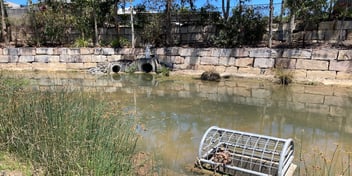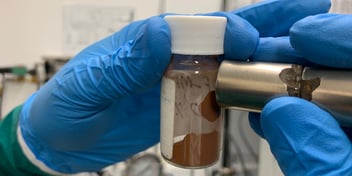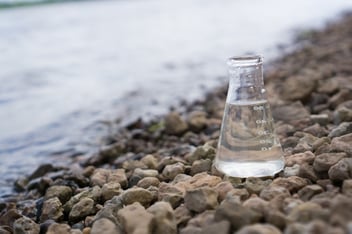Hitchhiking viruses pose potential health risks from microplastic pollution

New research has revealed the ability for viruses to “hitchhike” on the surface of microplastic particles – a finding that stirs up fresh concerns over the proliferation of microplastic pollution worldwide and the potential risks it poses to human and environmental health.
Published in Water Research, the University of Queensland study investigated the ability of polystyrene microplastics to carry viruses, including the one found inside E. coli bacteria.
University of Queensland’s Professor Jianhua Guo said the study showed that not only can viruses be retained on the surface of microplastics, the process can also prolong the lifespan of the pathogen.
“We often hear about the human and environmental harm caused by microplastics in water, but there is little known about whether the tiny microplastic particles can carry viruses,” he said.
“What we found is that viruses can hitchhike on microplastics and prolong their infectivity, which means there could be an increased risk of virus transmission throughout waterways and the environment.”
The team also tested how sun exposure and the size of microplastics helped prolong the virus’s survival and found the more environmental damage on the microplastic, the more likely it was to carry viruses.
Study co-lead Dr Ji Lu said virus-carrying microplastics could be a big issue, particularly in terms of disease outbreaks caused by the consumption of contaminated seafoods.
“By testing polystyrene particles of varying sizes, we found that more than 98% of the virus we used was found on the microplastic, and over half of the viruses could still be detected 10 days later – much longer than if the virus particles were free-floating in the water,” he said.
“The required dosage to be infectious to humans varies between different types of viruses, but there could be instances where the dosage is enough on a microplastic to cause potential infection.
“Because microplastics can potentially accumulate deadly viruses and travel through waterways, it might be risky to eat seafoods harvested from areas where they are frequently contaminated by microplastics.
“Our findings also indicated that microplastics could affect how viruses are distributed in water, which could be of interest in future studies.”
New questions
Lu said the study started when wastewater was being tested to detect COVID-19 cases in the community, which spurred the team’s investigation into what could mediate virus transmission in water environments.
“During the early stages of the pandemic, in late 2020 and early 2021, my colleagues and I were focusing on detecting the coronavirus in wastewater samples in Queensland, Australia. But since coronaviruses were so diluted or degraded in wastewater, we were struggling to detect a positive signal,” he said.
“During this detection process, we found that we had to concentrate several litres of wastewater to successfully detect the virus and get a positive signal.”
However, for all of the wastewater samples in the sludge phase, the researchers were able to detect a positive signal for the virus much easier.
“Basically, we found out there are more virus signals in the solid phase than in the liquid phase of wastewater. This led us to wonder: is there something else in the solid phase of the wastewater that is absorbing the virus? That’s really where this research began,” Lu said.
“We thought there might be a dominance of a certain micro-sized contaminant in the wastewater that was absorbing the virus.”
“One of the potential contaminants is microplastic. It is a hot topic at the moment and we have increasing reports detecting microplastics in all sorts of water environments, such as seawater, wastewater and even in drinking water.
New focus
After screening all of the possible candidates, the researchers found that microplastics may be one of the emerging contaminants that’s performing this virus absorption.
Lu said the finding is an important development in the broader study of microplastics, as biological contaminants like viruses don’t need to be present in high concentration to cause big problems.
“Before our study, publications were mainly focusing on the chemical contaminant absorption of microplastics, such as heavy metals, pharmaceuticals and antibiotics.” Lu said.
“But we haven’t yet had any studies looking at the absorption of virus contaminants onto microplastics.
“In relation to comparing contaminants, biological contaminants might be of more concern. Chemical contaminants need to reach a certain concentration to reach the side-effect threshold. But biological contaminants can replicate. So even if there is the smallest amount of exposure, they can replicate in the body and cause diseases.”
Lu said recent instances of seafood associated viral outbreaks, including in the US and China, highlight that hitchhiking viruses may pose significant risks to the health of communities.
“There are already many reports on seafood associated virus outbreaks, such as norovirus and hepatitis, and they are all linked to raw seafood consumption,” he said.
“Seafoods like oysters and mussels filter seawater to get food, and there have been reports that they contain microplastic contamination. If viruses are able to hitchhike on microplastics that then accumulate in these seafoods, this could cause a viral infection and risk a viral outbreak.
“Our study identified this potential risk of virus adsorption on microplastics in the water environment, but this risk needs to be further evaluated.”
New research
Lu said the findings have opened the door to further research that is needed in this area, including to test if other pathogens can hitchhike on more types of microplastics.
“We did a basic, preliminary study. We only focused on polystyrene microplastic, we haven’t looked at other microplastics types or shapes yet. But this research opens the door for further enquiry,” he said.
“One potential research pathway is to evaluate these risks within the real, environmental matrix.
“Currently, for all kinds of studies on environmental contamination, we are still focusing on very limited types of contaminants. Because we want to evaluate one certain contaminant, we tend to look at them in isolation.
“But in the real environmental scenario we have a lot of different types of emerging contaminants. All of them coexist in our environment, especially in water and wastewaters.”
Lu said it will be important for future research to focus more on how contaminants interact with each other in natural environments.
"For studies in the future, we should be focusing more on the real environmental matrix to see how different contaminants interact with each other to cause either synergistic effects or other effects, too,” he said.
“The fact that viruses and microplastics can interact with each other could be problematic for human health, but more research needs to be conducted to investigate these impacts further.”
University of Queensland researchers Dr Zhigang Yu and Lyman Ngiam were also involved in the study, which was funded by the Australian Research Council Discovery Project, and the Advance Queensland Industry Research Fellowship.



